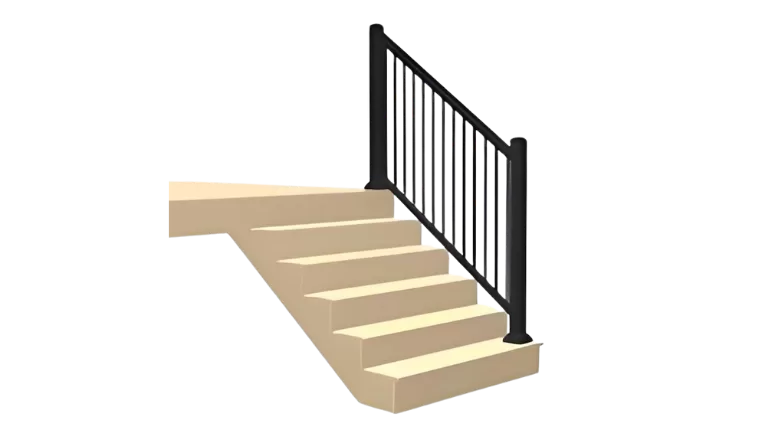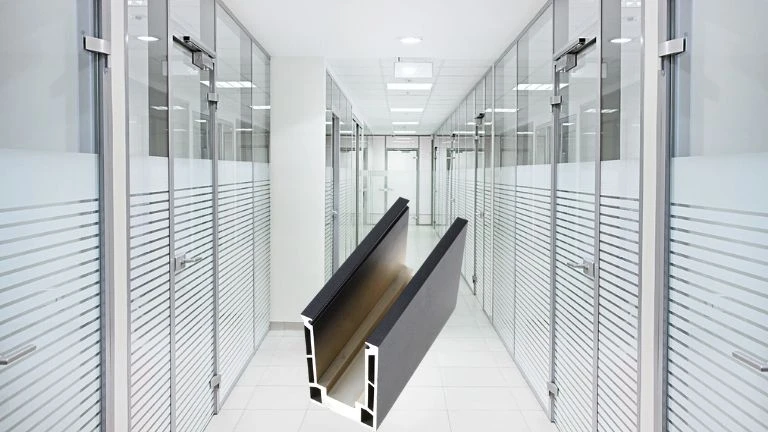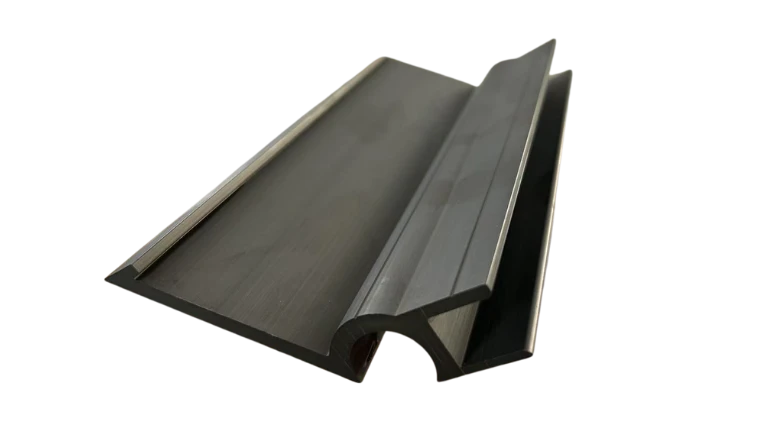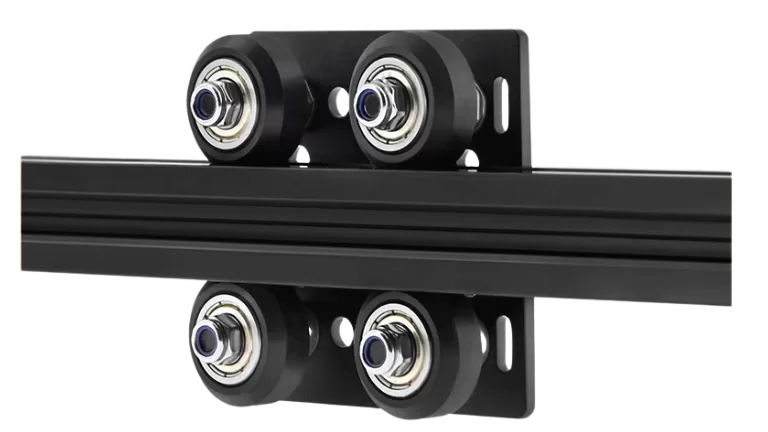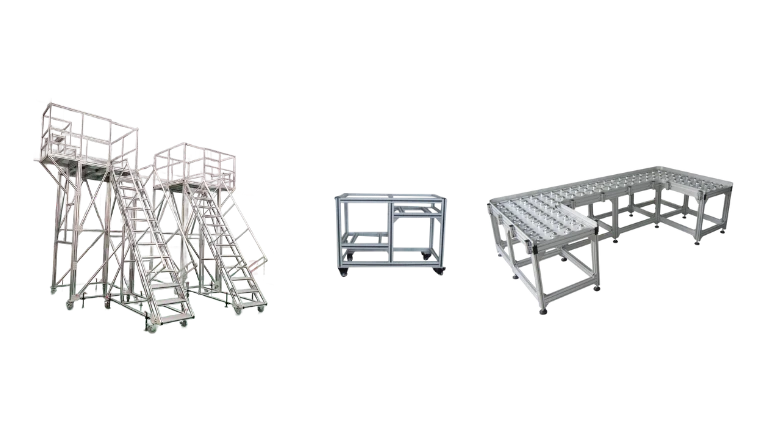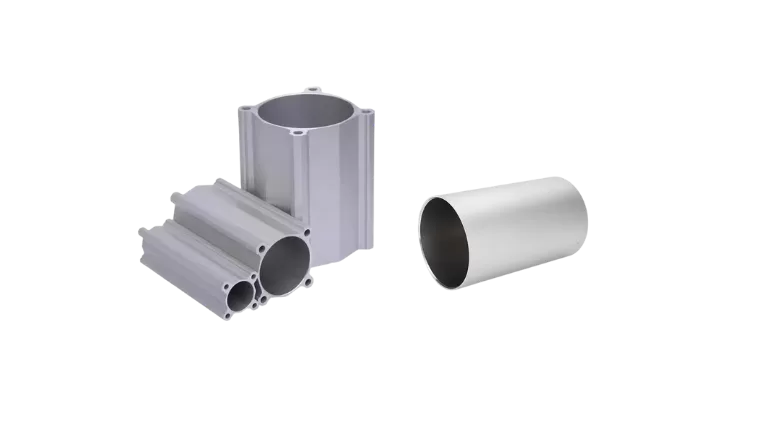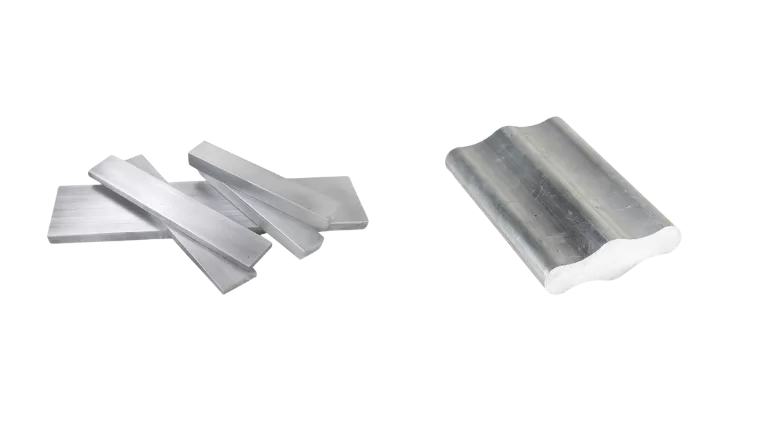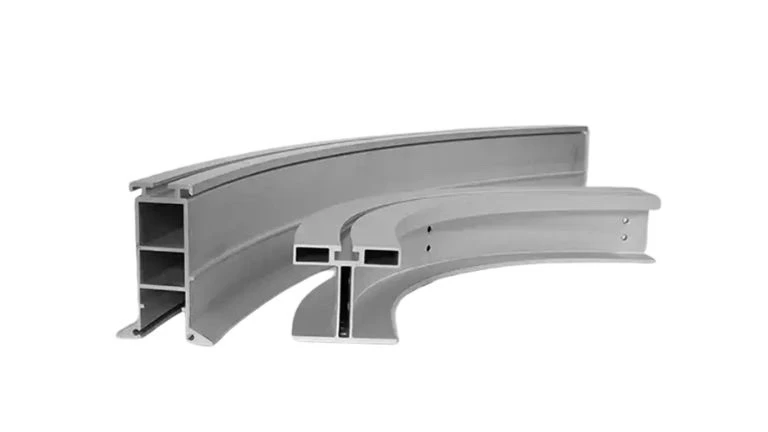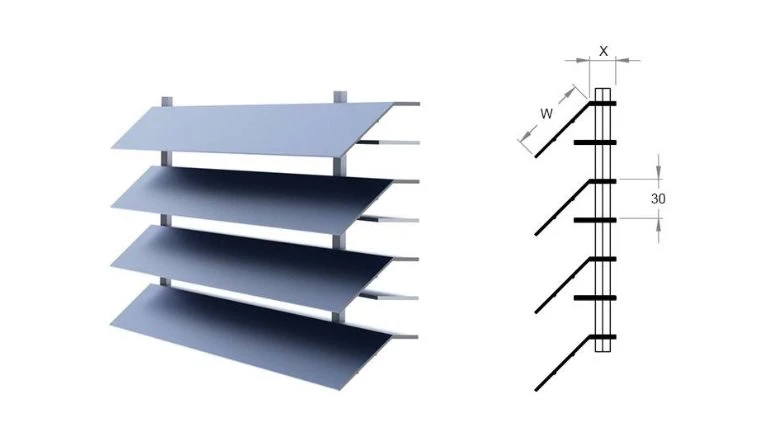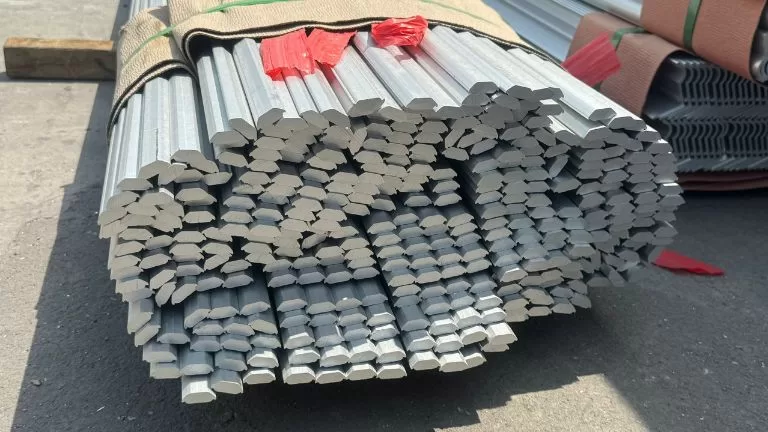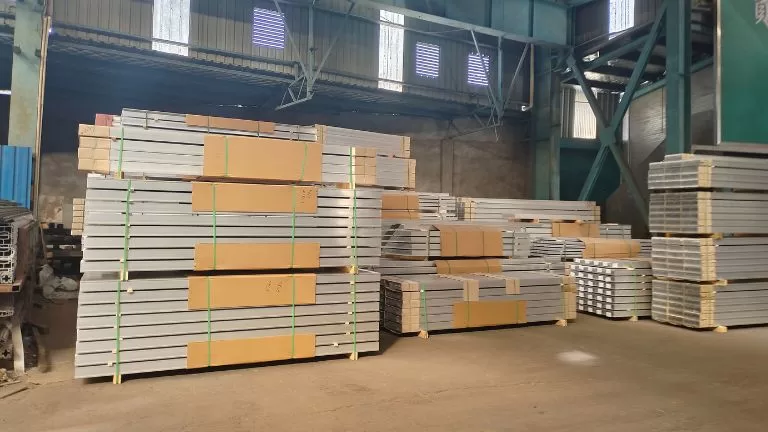Custom Black Aluminum Stair Railing Profile
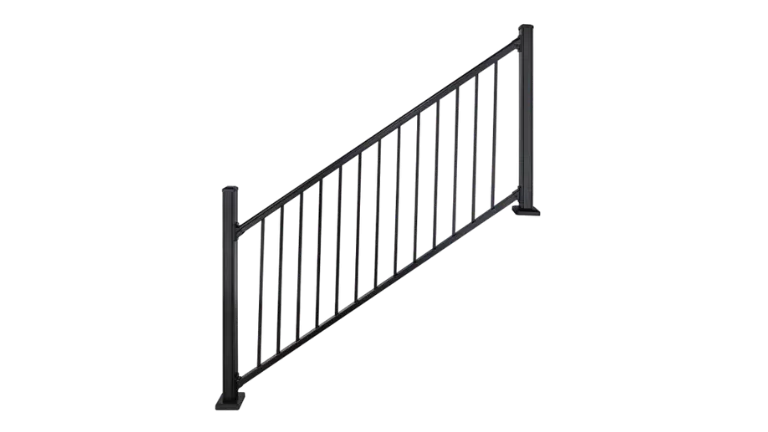
Choose us for your custom black aluminum stair railing needs. We provide precise mold development, premium surface finishes, expert machining, and fast delivery to ensure exceptional results every time.
-
Tailored Mold Development: We create custom molds to ensure your aluminum stair railing fits your design and dimensions perfectly.
-
Premium Surface Treatment: We offer advanced finishes such as anodizing and powder coating, giving your railing a sleek, durable black appearance.
-
Precision Machining: High-precision CNC machining delivers smooth lines and consistent quality for every component.
-
Fast Delivery: Our streamlined process ensures your custom black aluminum stair railing is delivered quickly and on time.
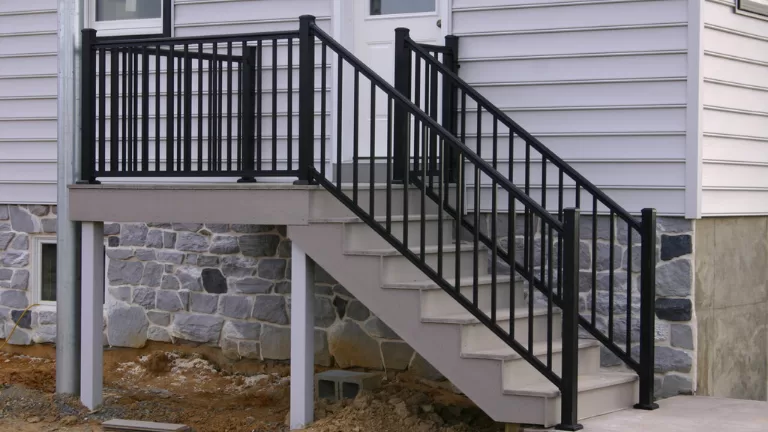
Post-and-Rail Railing
Structure: This system consists of vertical posts (typically spaced 60–120 cm apart), a top rail, a bottom rail, and intermediate pickets. The pickets can be made of aluminum tubes, stainless steel cables, or glass, with black aluminum pickets being the most common. The spacing of the pickets must comply with building codes to prevent children from climbing through.
Features: Stable, versatile, and easy to install; fits straight, L-shaped, and curved stairs.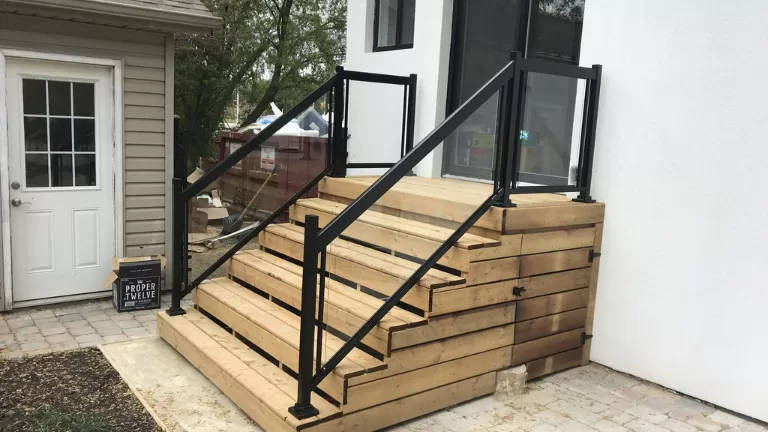
Glass and Aluminum Railing
Structure: The posts and rails are constructed from black aluminum tubes, while the infill consists of tempered glass panels secured with aluminum clamps or channels.
Features: Modern and open design; combines clear views with bold black accents.
Cable and Aluminum Railing
Structure: Vertical posts are made of black aluminum, and stainless steel cables replace traditional pickets. The cables are anchored at both ends with aluminum fittings.
Features: Minimalist look; unobstructed views; ideal for contemporary spaces.Advantages of Black Aluminum Stair Railing
Durable and Rust-Resistant
The aluminum construction offers excellent resistance to rust, corrosion, and weather for long-lasting outdoor and indoor use.decoration.
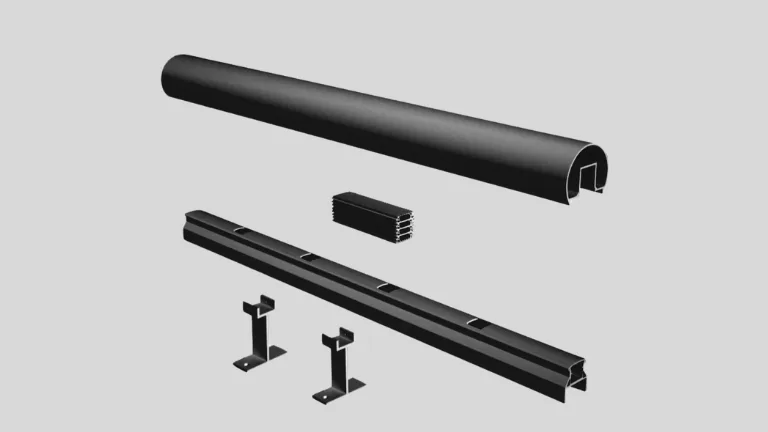
Sleek Modern Appearance
A smooth black finish and clean lines deliver a contemporary aesthetic that complements various architectural styles.

Lightweight and Strong
Aluminum railings combine a lightweight structure with impressive strength, ensuring safety without adding extra load.
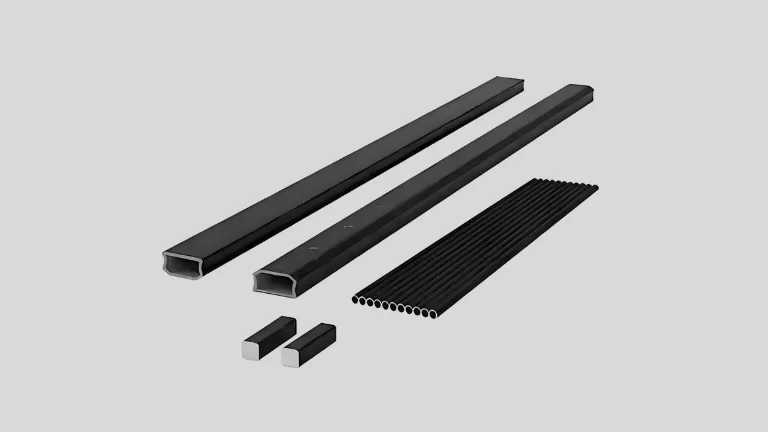
Low Maintenance Requirements
Surface treatments like anodizing and powder coating make the railing easy to clean and maintain, requiring minimal upkeep.
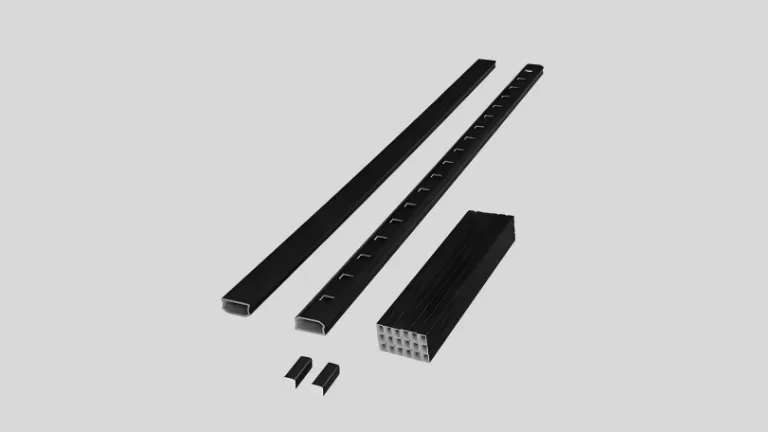
Customizable to Fit Your Needs
Various styles, heights, and installation options can be customized to suit project requirements and personal preferences.
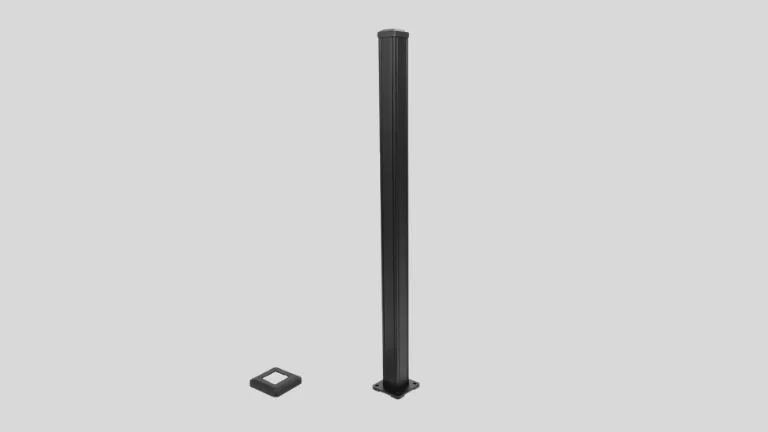
Quick and Simple Installation
Precise manufacturing and modular designs enable fast, hassle-free installation on different types of staircases.

Common Material Grades for Black Stair Railing
When choosing black aluminum stair railings, selecting the right material grade is essential for achieving the desired balance of strength, appearance, and durability. Here are some common material grades used:
1. 6061 Aluminum Alloy
Widely used due to its excellent mechanical properties, good corrosion resistance, and ease of welding and fabrication. Ideal for structural components in stair railings.
2. 6063 Aluminum Alloy
Popular for architectural applications because of its smooth surface finish, good extrudability, and strong resistance to weathering. Often chosen for handrails and decorative elements.
3. 6005 Aluminum Alloy
Provides higher strength compared to 6063, while still maintaining good formability. Used in cases where extra rigidity is required for rails or posts.

Common Applications of Black Stair Railing
1. Residential Staircases
Used in homes, apartments, and townhouses to provide safety and a modern look for indoor or outdoor stairs.
2. Commercial Buildings
Installed in offices, shopping malls, hotels, and restaurants for both functionality and stylish design.
3. Balconies and Terraces
Applied as safety railings on balconies, decks, and terraces, ensuring strong protection with a sleek appearance.
4. Public Infrastructure
Utilized in schools, hospitals, and public facilities to guarantee safe movement on staircases and access ramps.
5. Industrial Facilities
Employed in warehouses, factories, and workshops where safety, durability, and low maintenance are essential.
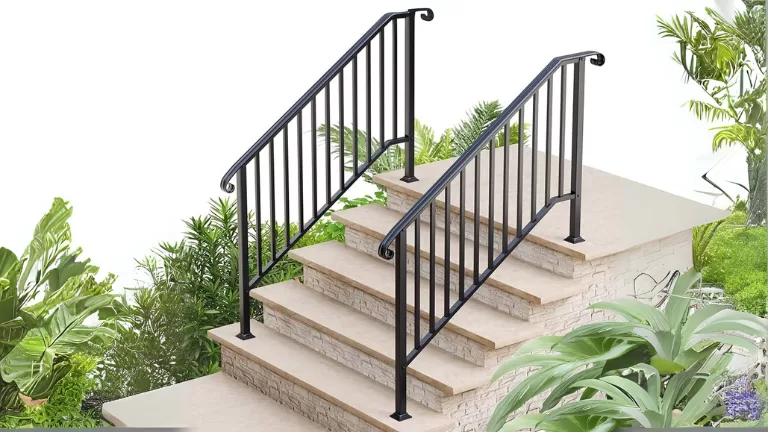
Processing Capacity
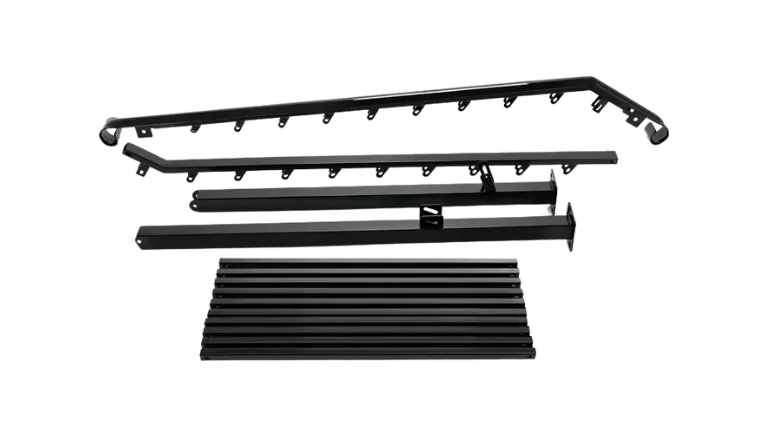 We have the capability to design and manufacture extrusion molds in-house specifically for black aluminum stair railing profiles. Our skilled team collaborates with clients to develop custom molds based on their designs or samples, ensuring each railing component meets exact project requirements. Mold production generally takes around 7 days, after which we supply samples for client approval before mass production begins.
We have the capability to design and manufacture extrusion molds in-house specifically for black aluminum stair railing profiles. Our skilled team collaborates with clients to develop custom molds based on their designs or samples, ensuring each railing component meets exact project requirements. Mold production generally takes around 7 days, after which we supply samples for client approval before mass production begins.
 Our production facility is equipped with over 40 advanced extrusion lines, including high-capacity presses, allowing us to manufacture aluminum profiles specifically for black stair railings. This enables us to supply a broad selection of shapes and sizes, from standard railings to custom profiles that meet unique architectural and project requirements. Our flexible production ensures we can efficiently serve both residential and commercial stair railing needs.
Our production facility is equipped with over 40 advanced extrusion lines, including high-capacity presses, allowing us to manufacture aluminum profiles specifically for black stair railings. This enables us to supply a broad selection of shapes and sizes, from standard railings to custom profiles that meet unique architectural and project requirements. Our flexible production ensures we can efficiently serve both residential and commercial stair railing needs.

For black aluminum stair railings, we offer a complete range of fabrication and finishing services. These include precise cutting, drilling, welding, assembly, and surface finishing to boost durability and appearance. Our tailored solutions ensure each railing fits seamlessly on-site, making installation easier and guaranteeing a high-quality result for any project.
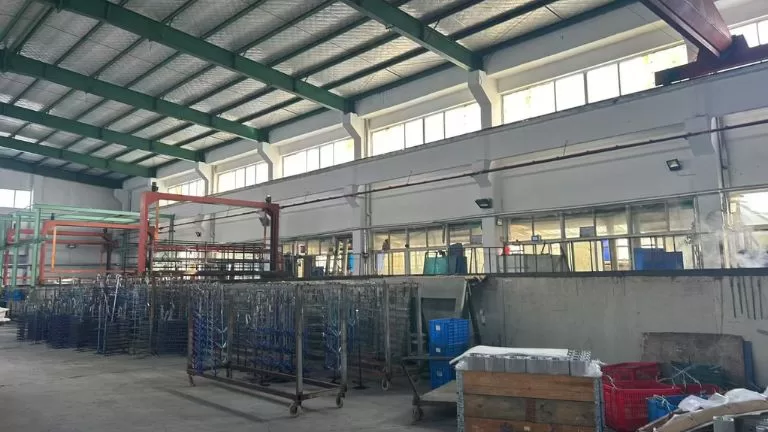
For black aluminum stair railings, we provide a range of surface treatments to ensure durability and a sleek appearance. Options include anodizing for strong corrosion protection, powder coating for a uniform black finish, and fluorocarbon coating for enhanced resistance to UV and harsh weather. These finishes are customized to meet aesthetic and functional requirements, ensuring long-lasting performance and style in any environment.
Structure and Accessories of Black Stair Railing
1. Main Rail (Handrail)
The primary horizontal or inclined bar that provides support and is held by users while ascending or descending stairs.
2. Posts (Balusters/Support Posts)
Vertical supports that are securely anchored to the stairs or floor, bearing the weight of the handrail and maintaining structural stability.
3. Infill Panels or Balusters
The space between posts is filled with either individual balusters (vertical rods) or infill panels (such as glass or metal sheets) for safety and decorative purposes.
4. Base Plates and Mounting Brackets
Robust plates or brackets fixed to the ground or stair structure, used to mount and secure the posts and rails firmly in place.
5. End Caps and Fittings
Caps are applied to the open ends of rails for a finished look, while various connecting fittings (such as elbows or joints) allow for changes in direction or angle.
6. Fasteners (Screws, Bolts, Anchors)
Stainless steel or corrosion-resistant fasteners are used throughout the system to ensure solid connections between all structural and accessory components.

Our Factory
Our factory is equipped with 40 extrusion production lines to efficiently manufacture aluminum profile. We have one anodizing and electrophoresis line, along with two vertical spraying machines and two horizontal spraying machines for surface treatment. Additionally, we operate two sandblasting machines and six wood grain transfer printing lines, enabling us to provide various aesthetic finishes. To support our production, we also have furnaces for casting aluminum bars, aging furnaces, annealing furnaces, water cooling treatment equipment, and machining equipment, ensuring comprehensive capabilities for high-quality output.
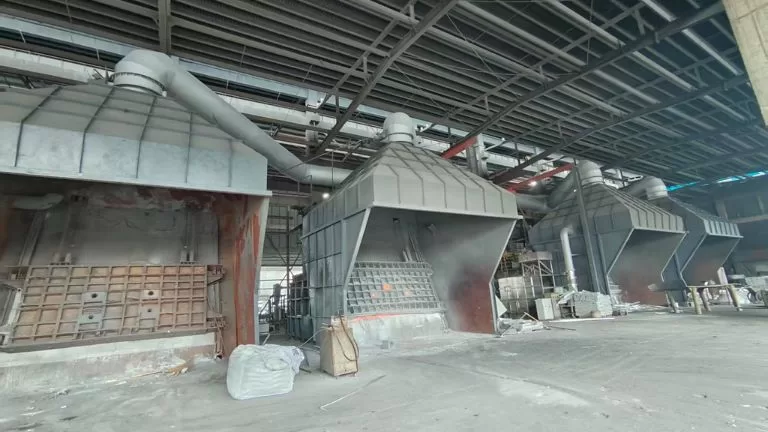
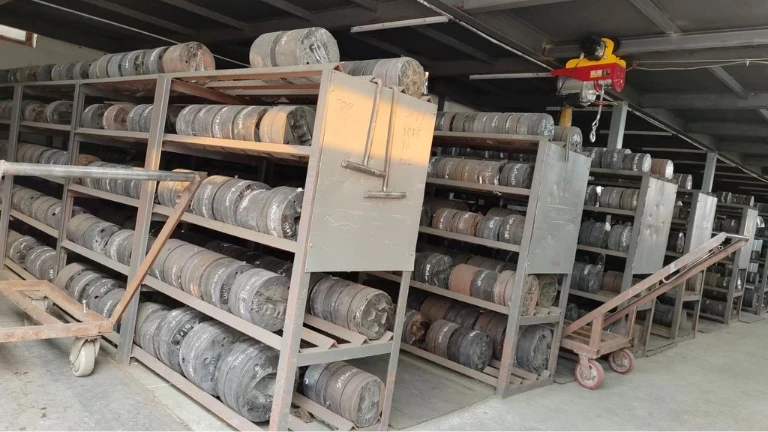

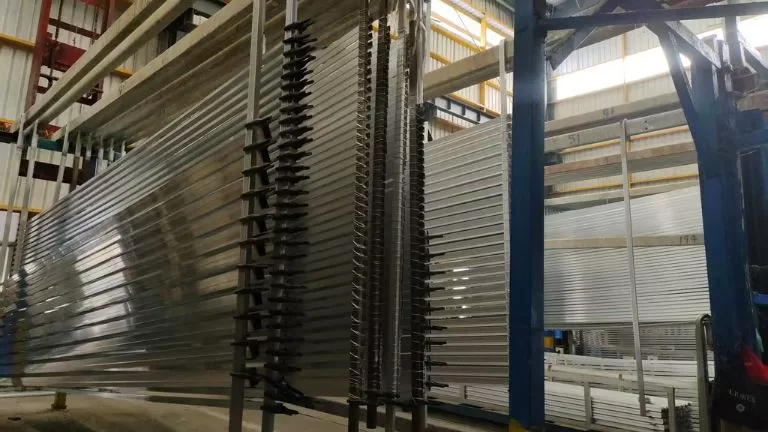
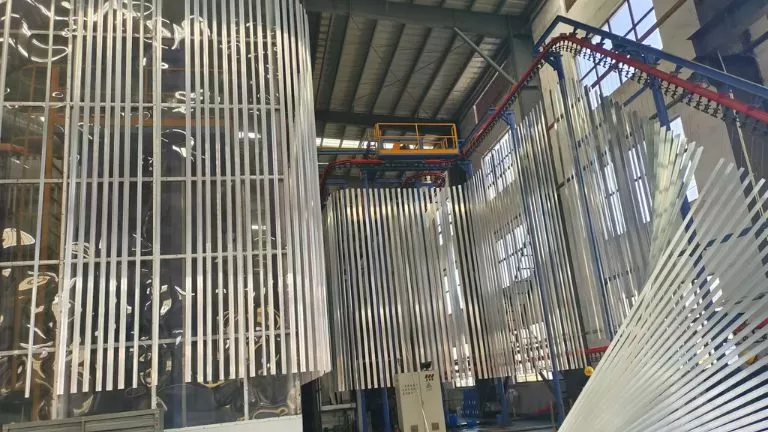
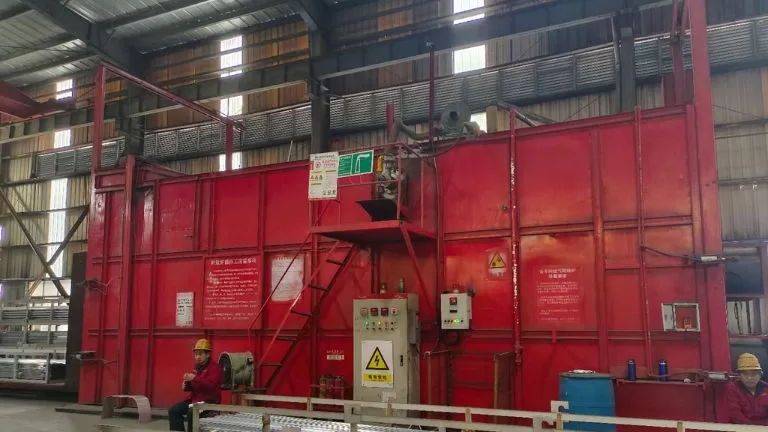

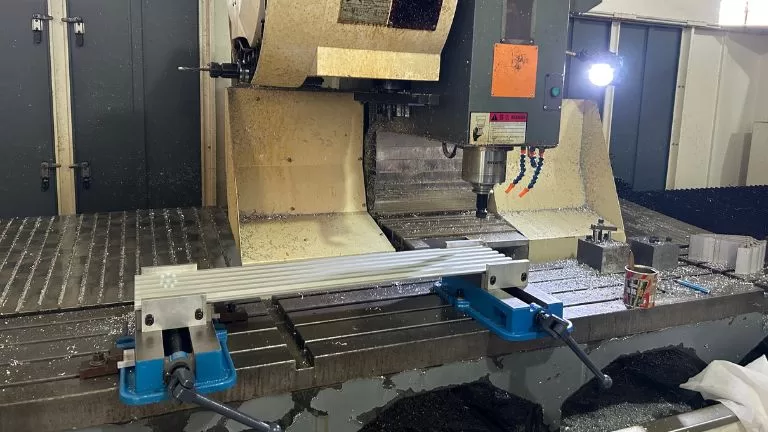
RFQ of Extruded Black Stair Railing
Installation:
- Modular design with standardized components (such as posts, handrails, and connectors) makes on-site assembly quick and efficient.
- Parts are securely joined using screws and brackets, simplifying the installation process.
- Installation can be customized to fit various stair sizes and architectural requirements.
Maintenance:
- Routine cleaning only requires mild soap and water to remove dust and debris.
- The corrosion-resistant surface treatment minimizes the risk of rust and fading.
- Periodically inspect the railing surface and connection points; promptly repair any scratches or damage to maintain appearance and safety.
The primary aluminum alloys used for extrusion belong to the 6xxx series, specifically 6061, 6063, 6060,6082 and 6066. These alloys are highly favored due to their excellent extrudability, good mechanical properties, and corrosion resistance.
- 6061: A versatile alloy with higher strength, suitable for structural and transportation applications.
- 6063: Known as the “architectural alloy,” it offers excellent surface finish and is widely used for decorative and structural purposes.
- 6060: Similar to 6063 but with slightly lower strength, ideal for intricate and thin-walled profiles.
- 6066: A high-strength alloy within the 6xxx series, often used in more demanding structural applications.
- 6082: A strong alloy with better mechanical properties compared to 6061 and excellent corrosion resistance, commonly used in high-load structural applications and in marine environments.
The 7xxx series alloys, such as 7075, are used in applications requiring extremely high strength and performance, such as aerospace and high-end engineering projects. However, they have lower corrosion resistance when compared to 6xxx alloys and are therefore less commonly used for general extrusion applications.
While 1xxx, 3xxx, and 5xxx series alloys can be extruded, they are generally used infrequently for extrusion due to their lower strength or other limitations compared to 6xxx and 7xxx alloys. These series are mainly used in specialized applications. Additionally, if extrusion products from these series are requested, higher minimum order quantities (MOQ) are typically required for custom production, as their demand is relatively low.
The heat treatment of aluminum extrusions determines their mechanical properties, strength, and suitability for specific applications. Among the various heat treatment methods, T5, T6, and T66 are the most commonly used. Here’s an in-depth look:
| Heat Treatment State | Cooling Method | Strength | Key Features and Benefits | Applications |
|---|---|---|---|---|
| T5 | Air cooling (fan) | Moderate | Adequate strength, good dimensional stability, used for architectural purposes. | Windows, doors, curtain walls, building structures. |
| T6 | Water quenching (fast) | High | Higher strength and hardness, ideal for industrial and structural uses. | Automotive, aerospace, machinery, transport parts. |
| T66 | Water quenching (fast) | Very high | Optimized mechanical properties for higher strength and performance demands. | Automotive, rail transportation, high-end machinery. |
Other Heat Treatment States
- T4: Solution heat-treated and naturally aged. Used in applications requiring intermediate strength and enhanced formability.
- T7: Overaged for better stress-corrosion resistance, often used for aerospace and marine purposes.
- O (Annealed): Very soft condition suitable for extensive forming or bending requirements.
- F (As-Fabricated): No heat treatment applied, used in non-critical applications with low strength requirements.
Aluminum extrusions undergo various surface treatments to enhance aesthetics, corrosion resistance, and functionality. Here are the common surface treatment methods used in the industry:
Main Surface Treatment Methods
Anodizing (Oxidation)
- Process: A controlled electrochemical process that forms a protective oxide layer on the aluminum surface.
- Features:
- Provides a durable, corrosion-resistant, and environmentally friendly finish.
- Produces a metallic finish with a variety of natural tones (e.g., silver, black, bronze).
- Improves surface hardness and protects against scratching.
- Applications: Architectural frames, decorative profiles, heat sinks.
Electrophoresis Coating (E-Coating)
- Process: After anodizing, the aluminum is coated with paint using an electrochemical process.
- Features:
- Enhances corrosion resistance and offers a smooth, glossy finish.
- Provides more color and texture variation compared to anodizing alone.
- Applications: Furniture profiles, indoor architectural components.
Powder Coating
- Process: Electrostatic application of powder paint, followed by curing under high temperature to form a solid coating.
- Features:
- Wide variety of colors and textures.
- Excellent weather resistance and corrosion protection.
- Cost-effective and highly versatile.
- Applications: Outdoor frames, fences, railings, general industrial use.
PVDF Coating (Polyvinylidene Fluoride)
- Process: A specialized fluoropolymer coating is applied in multiple layers, commonly over a pretreated surface.
- Features:
- Exceptional weather resistance and UV stability.
- Highly durable, resistant to fading, chalking, and chemical damage.
- Ideal for long-term outdoor use.
- Applications: Curtain walls, high-performance architectural facades.
Wood Grain Transfer Printing
- Process: A heat-transfer printing process that applies a wood grain effect onto a pre-coated aluminum surface.
- Features:
- Mimics the appearance of wood while retaining aluminum’s durability.
- Lightweight and weather-resistant alternative to natural wood.
- Applications: Furniture, decorative coverings, outdoor panels.
Film Lamination
- Process: Adhesive application of a protective or decorative film onto the aluminum surface.
- Features:
- Provides a glossy, textured, or patterned finish.
- Often used for applications requiring specific textures like marble or leather effects.
- Applications: Interior decor, windows.
Pre-Treatment Processes
Prior to surface treatment, the aluminum surface can be pre-processed for specific textures or finishes:
Brushing/Polishing
- Removes surface imperfections and creates a smooth, reflective finish.
- Often used for decorative purposes.
Sanding/Grinding
- Produces a matte or satin finish by applying abrasives.
Shot Blasting/Sandblasting
- Sprays abrasives at high velocity to create a textured surface, often used before anodizing for a uniform appearance.
Stretching and Tension Leveling
- Straightens the aluminum profile and improves shape accuracy after extrusion.
Cost and Durability Comparison Table
| Treatment Method | Process Cost | Surface Durability | Weather Resistance | Applications |
|---|---|---|---|---|
| Anodizing (Oxidation) | Medium | Very Durable | High | Architectural frames, industrial parts. |
| Electrophoresis (E-Coating) | Medium-High | Durable | Medium | Furniture, indoor parts, decorative uses. |
| Powder Coating | Medium | Highly Durable | High | Outdoor frames, industrial fixtures. |
| PVDF Coating | High | Extremely Durable | Excellent | Curtain walls, high-end exteriors. |
| Wood Grain Printing | Medium | Moderate (topcoat dependent) | Medium | Decorative panels, furniture. |
| Film Lamination | Low-Medium | Moderate | Low | Indoor decorations, windows. |
| Brushing/Sandblasting (Pre-Treatment) | Low | Not Applicable (Preparation only) | N/A | Preparation for further treatment. |
. Anodizing (Oxidation)
- Common Colors:
Natural silver
Black
Champagne
Light bronze
Dark bronze
Gold
2. Electrophoresis Coating (E-Coating)
- Common Colors:
Black
Champagne
Light bronze
Dark bronze
Custom metallic colors
3. Powder Coating
- Colors:
Can match any color based on the RAL color chart.
Offers textures like matte, gloss, satin, and custom finishes.
4. PVDF Coating (Polyvinylidene Fluoride)
- Colors:
Also customizable using the RAL color chart.
High-end finishes with matte or glossy effects.
5. Wood Grain Transfer Printing
- Colors and Patterns:
Mimics various wood types (e.g., oak, walnut, teak, mahogany).
Custom patterns available based on provided samples.
6. Film Lamination
- Colors and Patterns:
Includes textures like marble, leather, and solid colors.
Custom finishes and patterns based on provided samples.
Pre-Treatment Options (Impact on Final Color)
- Brushing/Polishing: Produces smooth or reflective metallic surfaces.
- Sandblasting: Adds a rough, matte texture before the final surface treatment.
We provide a wide range of machining services for aluminum extrusions to meet specific requirements. These include cutting off/section removal, slotting, drilling holes, tapping threads, bending, and localized stamping to create deformations. For example, we can trim extruded profiles to custom lengths, mill precise grooves, create threaded holes for fasteners, bend profiles into specific shapes, or apply localized stamping to achieve custom forms or deformation.
In addition to these processes, we also offer TIG/MIG welding to join aluminum components for a solid structure. Furthermore, our services include assembly of common accessories, such as brackets, corner connectors, screws, hinges, end caps, and rubber seals, providing complete and ready-to-install profile solutions tailored to your project needs. This ensures that we can handle everything from simple cuts to highly customized fabrication and assembly, all with precision and efficiency.
For custom aluminum extrusion projects, we accept a variety of drawing formats, including CAD files, STEP files, and PDF files. However, for extrusions that require additional machining processes, it’s recommended to provide STEP files, as they ensure precise 3D modeling for machining accuracy.
While PDF files are acceptable, converting them into CAD drawings may result in the loss of certain details, requiring us to manually redraw the design, which could increase lead time. For the fastest and most accurate quotation, we recommend providing CAD files (e.g., DWG/DXF) and STEP files to ensure efficient design evaluation and pricing.
Mold fees are an essential part of the custom aluminum extrusion process. Since every order requires a uniquely designed mold tailored to specific requirements, these molds cannot be used for other products. Therefore, the mold fee is necessary and non-negotiable.
We require 100% upfront payment of the mold fee before mold development begins to ensure timely production. However, as a token of appreciation for your support, we offer a refund of the mold fee or equivalent discounts once the order reaches a certain production volume. Specific policies can be discussed based on your order volume and collaboration details.
Our minimum order quantity (MOQ) varies depending on the size of the product. For smaller-sized products, the MOQ is typically 500kg, while for larger-sized products, it is 2 tons.
We will specify the exact MOQ requirements during the quotation process. If your order quantity does not meet the MOQ, we can still arrange production, but an additional fee will be applied to cover mold preheating and production setup time. Rest assured, this extra fee will be reasonable, and we aim to keep it as minimal as possible to ensure smooth cooperation.
Packaging can be customized according to your needs. Options include using protective film or paper to separate and protect the surface, or foam film for additional surface protection. Products can be palletized or packed into cartons, and the quantity per pallet or carton can be specified by the customer.
The standard packaging involves bundling several pieces together with plastic wrap and then securing them onto pallets. Any packaging requirements beyond the standard will be accommodated, and the associated costs will be clearly provided to the customer.
Mold production typically takes 7 days. After the sample is confirmed, producing a full container load of 26 tons generally requires 14 days for extrusion alone. If surface treatment is required, an additional 3 days will be needed. For machining, extra time will be required depending on the complexity and volume of the machining work. The exact additional time for machining will be determined based on the specific processing requirements.
Aluminum profiles are naturally corrosion-resistant due to the formation of a thin, protective oxide layer when exposed to air or water. This oxide layer is stable and self-repairing, meaning that even if the surface is scratched or cut (such as at exposed ends or during processing), the aluminum will not rust or corrode like iron or steel. Instead, the exposed areas will quickly form a new oxide layer, providing continuous protection against further oxidation.
With proper design, installation, and maintenance, aluminum profiles can last for decades, even in challenging environments. For example, untreated aluminum can easily withstand 20-30 years in outdoor applications, while profiles with surface treatments like anodizing or powder coating can last even longer, often exceeding 50 years. This makes aluminum an excellent choice for applications where durability and long-term performance are essential.
The price of aluminum profiles consists of several components: raw material costs, extrusion processing fees, surface treatment fees, machining costs, and additional packaging fees. Among these, the cost of aluminum as a raw material tends to fluctuate frequently, while other fees remain relatively stable. Due to these fluctuations, our quotations are typically valid for 7 days.
Pricing can be structured in different ways depending on the product and requirements. It can be calculated by weight (e.g., cost per ton), by length (e.g., cost per meter), or by piece (e.g., cost per unit). For products involving extensive machining, such as heat sinks, pricing is generally calculated on a per-piece basis to accurately reflect the additional processing costs. This flexible pricing approach ensures the quote is tailored to the specific needs of the customer.
We can manufacture aluminum profiles in compliance with technical requirements that meet European standards (EN), American standards (ASTM/AA), or other standards as specified by the customer. Custom production is tailored to ensure that the profiles meet the specific standard requirements requested.
Our production equipment is designed for the metric system. If the drawings provided are in the imperial system, we will convert them into metric units for production to ensure accuracy.
It is important to note that while we can machine imperial-threaded holes for fasteners, if you require us to supply matching imperial fasteners, they may not always be available in stock. Custom orders for imperial fasteners typically require a large volume for production. Please consider this when planning your project.
